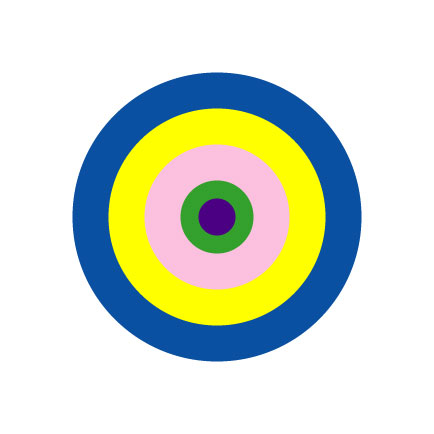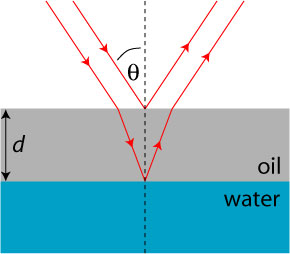A few days ago, I was wondeirng what else I could contribute to the celebration of the birthday of Charles Darwin, father of the theory of evolution which forms the cornerstone of modern biology. Of course, I’m an optical physicist, not a biologist, so my options for discussing Darwin’s life and work are limited.
Enter the Philosophical Transactions of the Royal Society of London, the oldest scientific journal in the English-speaking world! I was browsing the archives for the late 1700s when I came across a paper by Robert Waring Darwin, M.D., “New experiments on the ocular spectra of light and colours,” Phil. Trans. Roy. Soc. 76 (1786), 313. The paper was communicated by Erasmus Darwin, M.D., F.R.S.: Darwin’s grandfather! Robert Waring Darwin is the father of Charles Darwin — and he wrote a paper about optical phenomena!
The paper is actually a collection of observations regarding vision, and these observations are straightforward and can be readily repeated by anyone who is interested. So, to celebrate Darwin in my own, weird way, I thought I’d look at the paper of Robert Waring Darwin!
I was not entirely convinced at first that the ‘Robert Waring Darwin’ mentioned here was Darwin’s Dad (truth be told, I’m still not sure). There is an elder Robert Waring Darwin, Erasmus Darwin’s older brother, who was also a physician and scientist who focused on botany and published Principia Botanica in 1787. Making things a little more suspicious, Darwin’s father R.W. Darwin was born in 1766, and would only have been twenty at the time he presented his paper at the Royal Society.
However, Darwin’s father did get his M.D. in 1786 from the University of Edinburgh, and it seems to fit that R.W. the younger would have ‘made his mark’ by presenting a paper on the physiology of vision at the Royal Society, communicated by his own father Erasmus. The younger R.W. was not a member of the Royal Society in 1786 when the paper was published, but did become a member in 1788. It also seems unlikely that the elder R.W. would have been presenting research on vision on the eve of completion of his magnum opus on botany, Principia Botanica. I’ll assume (pretend?) that this paper was written by Darwin’s Dad, until someone demonstrates otherwise!
The paper itself concerns observations on the physiology of vision, primarily focusing on the effects of afterimages which are perceived even after one looks away from the object, for example the spot one sees after staring at the sun (NOT recommended) or a bright lamp for an instant. The mechanisms by which the eye works were more or less still mysterious by the late 1700s, and anecdotal observations were apparently used to deduce the workings of the eye. In R.W.’s words,
When any one has long and attentively looked at a bright object as at the setting sun, on closing his eyes, or removing them, an image, which resembles in form the object he was attending to, continues some time to be visible: this appearance in the eye we shall call the ocular spectrum of that object.
These ocular spectra are of four kinds: 1st, Such as are owing to a less sensibility of a defined part of the retina; or spectra from defect of sensibility. 2d, Such as are owing to a greater sensibility of a defined part of the retina; or spectra from excess of sensibility. 3d, Such as resemble their object in its colour as well as form; which may be termed direct ocular spectra. 4th, Such as are of a colour contrary to that of their object; which may be termed reverse ocular spectra.
The laws of light have been most successfully explained by the great Newton, and the perception of visible objects has been ably investigated by the ingenious Dr. Berkeley and M. Malebranche; but these minute phænomena of vision have yet been thought reducible to no theory, though many philosophers have employed a considerable degree of attention upon them…
R.W.’s paper is rather long and filled with numerous afterimage effects, from which he deduces properties of the retina of the eye. I won’t go through the entire collection, but will highlight some of my favorites. From the section on ‘Activity of the retina in vision’, we have:
1. Place a piece of red silk, about an inch in diameter, as in fig. 1 on a sheet of white paper, in a strong light; look steadily upon it from about the distance of half a yard for a minute; then closing your eyelids cover them with your hands, and a green spectrum will be seen in your eyes, resembling in form the piece of red silk: after some time, this spectrum will disappear and shortly re-appear; and this alternately three or four times, if the experiment is well made, till at length it vanishes entirely.
2. Place on a sheet of white paper a circular piece of blue silk, about four inches in diameter, in the sunshine; cover the center of this with a circular piece of yellow silk, about three inches in diameter; and the center of the yellow silk with a circle of pink silk, about two inches in diameter; and the center of the pink silk with a circle of green silk, about one inch in diameter; and the center of this with a circle of indigo, about half an inch in diameter; make a small speck with ink in the very center of the whole, as in fig. 2; look steadily for a minute on this central spot, and then closing your eyes, and applying your hand at about an inch distance before them, so as to prevent too much or too little light from passing through the eyelids, you will see the most beautiful circles of colours that imagination can conceive, which are most resembled by the colours occasioned by pouring a drop or two of oil on a still lake in a bright day; but these circular irises of colours are not only different from the colours of the silks above-mentioned, but are at the same time perpetually changing as long as they exist.
3. When any one in the dark presses either corner of his eye with his finger, and turns his eye away from his finger, he will see a circle of colours like those in a peacock’s tail: and a sudden flash of light is excited in the eye by a stroke on it. (Newton’s Opt. Qu. 16.)
4. When any one turns round rapidly on one foot, till he becomes dizzy and falls upon the ground, the spectra of the ambient objects continue to present themselves in rotation, or appear to librate, and he seems to behold them for some time still in motion.
The last of these tests I find pretty amusing: try and picture the distinguished and venerable fellows of the Royal Society spinning around until they collapse on the ground!
Now you can celebrate Darwin’s birthday in a very special way: by reproducing some of his father’s vision experiments! (Though I don’t recommend number 4.)
For experiment 1, use the image below, but follow the link to the full-size image:
For experiment number 2, use the following image, again following the link to the full-size image:
I’ve tested both of these experiments and found them to work, though I have a hard time staring at the images for a full minute! In the second experiment, Darwin notes that the colors “most resembled by the colours occasioned by pouring a drop or two of oil on a still lake in a bright day”. The colors, to my eye, do appear as the colors of an oil spot, as illustrated below (picture taken from Wikipedia):
This effect is actually a nice illustration of the optics of thin films. The colors result from the interference of light which reflects off of the surface of the oil and the light which travels into the oil and reflects off of the water beneath:
I won’t go through the derivation, but if a light ray of wavelength is incident on a film of thickness d at angle
, the part of the ray which travels through the oil will be advanced by a phase
,
where is the refractive index of the oil. In short, because the phase difference depends on both the angle of incidence and the wavelength, different colors get preferentially reflected in different directions, creating a rainbow pattern.
Because of the curious nature of persistent colors on the retina, you can actually make a black-and-white image appear colored, as is shown in this “Big Spanish Castle” illusion. (h/t to Tom at Swans on Tea, quite some time ago!) I’m going to create and add my own version of this illusion to this post as soon as I find a suitable image from my collection.
Looking at some of the optical illusions created by a ‘defect of sensibility’, we have first:
When any one passes from the bright daylight into a darkened room, the irises of his eyes expand themselves to their utmost extent in a few seconds of time; but it is very long before the optic nerve, after having been stimulated by the greater light of the day, becomes sensible of the less degree of it in the room; and, if the room is not too obscure, the irises will again contract themselves in some degree, as the sensibility of the retina returns.
We’re all familiar with this problem: passing from the light to the dark, your eyes take some time to adjust to be able to see. This is a problem I’ll experience tonight when I try and get into bed without waking my fiancée! It is rumored, and it was treated on an episode of Mythbusters, that pirates wore eyepatches over perfectly good eyes to keep one eye dark-sensitive when going below-decks! I actually use this when going up to bed, now: by keeping one eye closed a minute or so before bed, I can produce a little better dark-sensitivity for wandering around with the lights off.
Here’s another one you can try:
Place about half an inch square of white paper on a black hat, and looking steadily on the center of it for a minute, remove your eyes to a sheet of white paper; and after a second or two a dark square will be seen on the white paper, which will continue some time. A similar dark square will be seen on the closed eye, if light be admitted through the eye-lids.
Below is a figure with the dark section (the ‘hat’) with the dot; you’ll have to supply your own white paper:
This is not a terribly exciting demonstration, but could have had practical consequences for credulous and superstitious people of R.W. Darwin’s time (remember, this is 1786). To quote R.W.,
As these spectra are more easily observable when our eyes are a little weakened by fatigue, it has frequently happened, that people of delicate constitutions have been much alarmed at them, fearing a beginning decay of their sight, and have thence fallen into the hands of ignorant oculists; but I believe they never are a prelude to any other disease of the eye, and that it is from habit alone, and our want of attention to them, that we do not see them on all objects every hour of our lives. But as the nerves of very weak people lose their sensibility, in the same manner as their muscles lose their activity, by a small time of exertion, it frequently happens, that sick people in the extreme debility of fevers are perpetually employed in picking something from the bed-cloaths, occasioned by their mistaking the appearance of these muscæ volitantes in their eyes. Benvenuto Celini, an Italian artist, a man of strong abilities, relates, that having passed the whole night on a distant mountain with some companions and a conjurer, and performed many ceremonies to raise the devil, on their return in the morning to Rome, and looking up when the sun began to rise, they saw numerous devils run on the tops of the houses, as they passed along; so much were the spectra of their weakened eyes magnified by fear, and made subservient to the purposes of fraud or superstition.
Emphasis totally mine! This is just another anecdote to add to the long list of “reasons why a little scientific knowledge is a good thing.”
One other effect is worth noting, in the section, “Of direct ocular spectra.” R.W. notes,
When a fire-coal is whirled round in the dark, a lucid circle remains a considerable time in the eye; and that with so much vivacity of light, that it is mistaken for a continuance of the irritation of the object. In the same manner, when a fiery meteor shoots across the night, it appears to leave a long lucid train behind it, part of which, and perhaps sometimes the whole, is owing to the continuance of the action of the retina after having been vividly excited. This is beautifully illustrated by the following experiment: fix a paper sail, three or four inches in diameter, and made like that of a smoke jack, in a tube of pasteboard; on looking through the tube at a distant prospect, some disjointed parts of it will be seen through the narrow intervals between the sails; but as the fly begins to revolve, these intervals appear larger; and when it revolves quicker, the whole prospect is seen quite as distinct as if nothing intervened, though less luminous.
The first of these effects is the basis of so-called ‘light painting‘, in which a long exposure photograph allows one to ‘paint’ lines of light on the photographic film, as in the picture below (taken from Flickr):
The later description, of viewing an image which is obstructed by a rotating sail through a narrow tube, is an awesome early illustration of the idea of persistence of vision, The occasional obstructions of the sail, when they pass by fast enough, end up being ‘averaged out’ by your eye and leaving you the impression of a continuous image. The same idea, that rapid changes will be ‘smoothed out’ by your vision, is the basis of motion pictures and animation!
*****
Hopefully you’ve enjoyed this brief look at the optical researches of Darwin’s Dad! Charles Darwin came from a distinguished family of scientists and it is perhaps not surprising that he followed the path that he did, in spite of initial resistance of his father to his trip on the Beagle!
As I was writing this post, MSNBC broadcast a speech by Barack Obama commemorating the anniversary of Abraham Lincoln’s birthday. During the speech, I was pleasantly surprised to hear Obama also acknowledge the important and impressive contribution Charles Darwin made to biological science!
Anyway, happy Darwin’s birthday, to all, and to all a good night!







